Design of Additive Manufactured Lattices for Dental Implants
VerifiedAdded on 2022/11/26
|28
|7157
|422
Project
AI Summary
This project report focuses on the design of additive manufactured lattices with graded porosities for dental implants. It begins with an introduction to dental implants and the advantages of additive manufacturing, highlighting the use of lattice structures and graded porosities to improve osseointegration. The literature review explores the impact of lattice structures and graded porosities in dental implantation, evaluating the benefits of the suggested process and identifying research gaps. The methodology outlines the approach used in the research, followed by findings and results, which analyze the effect of lattice structures and graded porosities. The report concludes with recommendations and suggestions for future work, emphasizing the potential of additive manufacturing to enhance dental implant design and improve patient outcomes. The report also discusses the benefits of using additive manufactured lattice structures with graded porosities in dental implantation, including improved biocompatibility, reduced stress shielding, and enhanced biomechanical controllability. The project also explores the limitations of the process, such as cost and potential risks, while emphasizing the overall advantages of this approach.
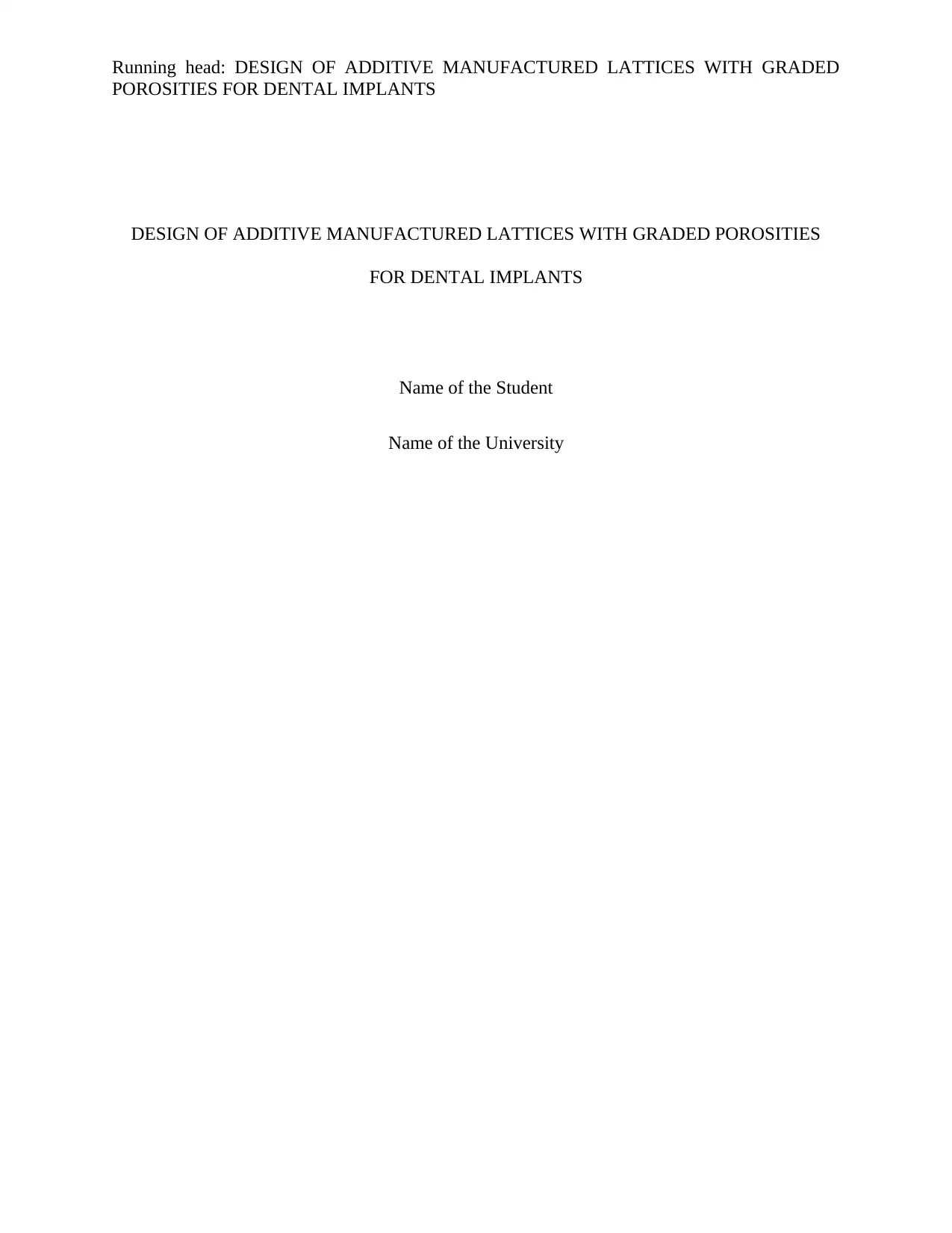
Running head: DESIGN OF ADDITIVE MANUFACTURED LATTICES WITH GRADED
POROSITIES FOR DENTAL IMPLANTS
DESIGN OF ADDITIVE MANUFACTURED LATTICES WITH GRADED POROSITIES
FOR DENTAL IMPLANTS
Name of the Student
Name of the University
POROSITIES FOR DENTAL IMPLANTS
DESIGN OF ADDITIVE MANUFACTURED LATTICES WITH GRADED POROSITIES
FOR DENTAL IMPLANTS
Name of the Student
Name of the University
Paraphrase This Document
Need a fresh take? Get an instant paraphrase of this document with our AI Paraphraser
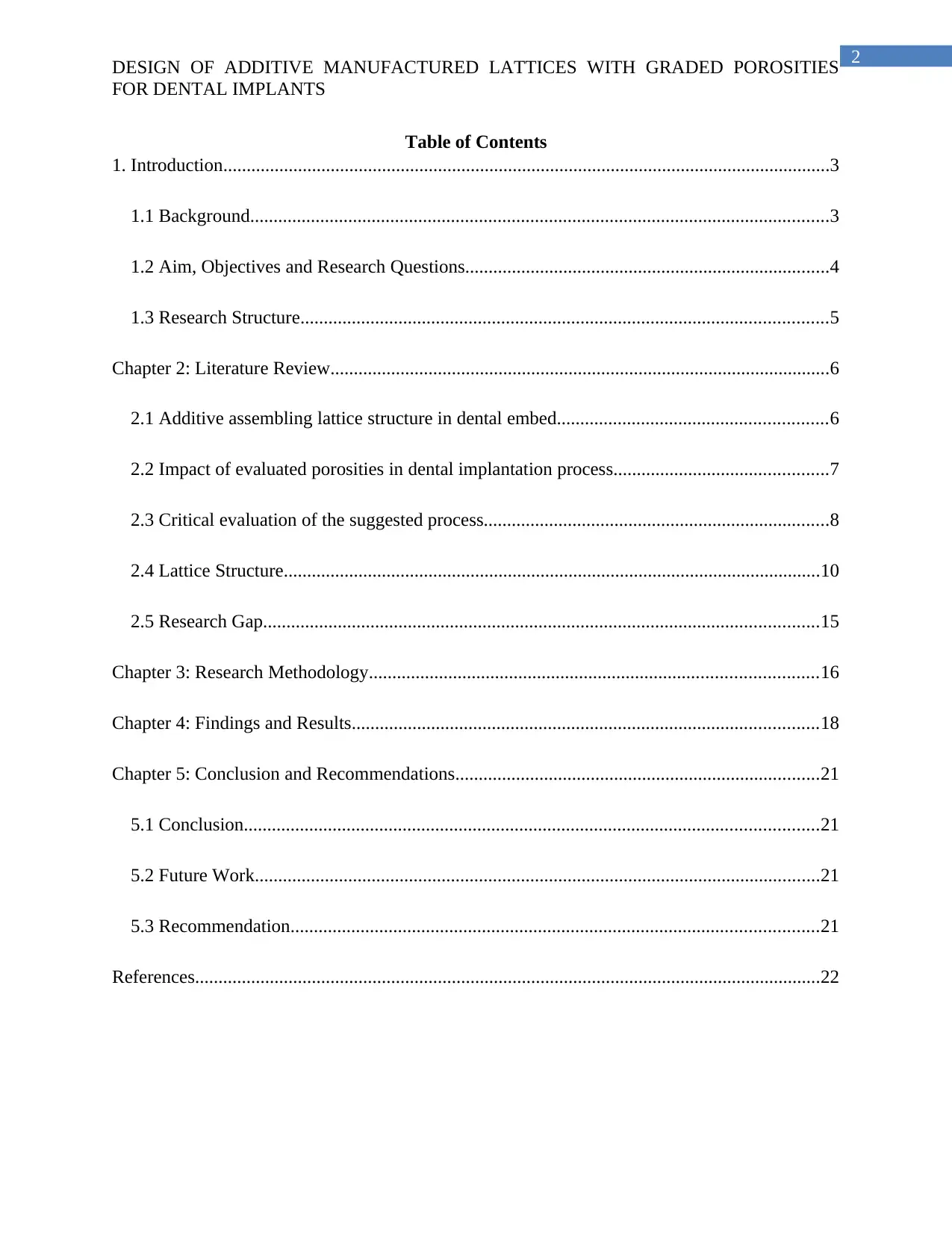
2
DESIGN OF ADDITIVE MANUFACTURED LATTICES WITH GRADED POROSITIES
FOR DENTAL IMPLANTS
Table of Contents
1. Introduction..................................................................................................................................3
1.1 Background............................................................................................................................3
1.2 Aim, Objectives and Research Questions..............................................................................4
1.3 Research Structure.................................................................................................................5
Chapter 2: Literature Review...........................................................................................................6
2.1 Additive assembling lattice structure in dental embed..........................................................6
2.2 Impact of evaluated porosities in dental implantation process..............................................7
2.3 Critical evaluation of the suggested process..........................................................................8
2.4 Lattice Structure...................................................................................................................10
2.5 Research Gap.......................................................................................................................15
Chapter 3: Research Methodology................................................................................................16
Chapter 4: Findings and Results....................................................................................................18
Chapter 5: Conclusion and Recommendations..............................................................................21
5.1 Conclusion...........................................................................................................................21
5.2 Future Work.........................................................................................................................21
5.3 Recommendation.................................................................................................................21
References......................................................................................................................................22
DESIGN OF ADDITIVE MANUFACTURED LATTICES WITH GRADED POROSITIES
FOR DENTAL IMPLANTS
Table of Contents
1. Introduction..................................................................................................................................3
1.1 Background............................................................................................................................3
1.2 Aim, Objectives and Research Questions..............................................................................4
1.3 Research Structure.................................................................................................................5
Chapter 2: Literature Review...........................................................................................................6
2.1 Additive assembling lattice structure in dental embed..........................................................6
2.2 Impact of evaluated porosities in dental implantation process..............................................7
2.3 Critical evaluation of the suggested process..........................................................................8
2.4 Lattice Structure...................................................................................................................10
2.5 Research Gap.......................................................................................................................15
Chapter 3: Research Methodology................................................................................................16
Chapter 4: Findings and Results....................................................................................................18
Chapter 5: Conclusion and Recommendations..............................................................................21
5.1 Conclusion...........................................................................................................................21
5.2 Future Work.........................................................................................................................21
5.3 Recommendation.................................................................................................................21
References......................................................................................................................................22
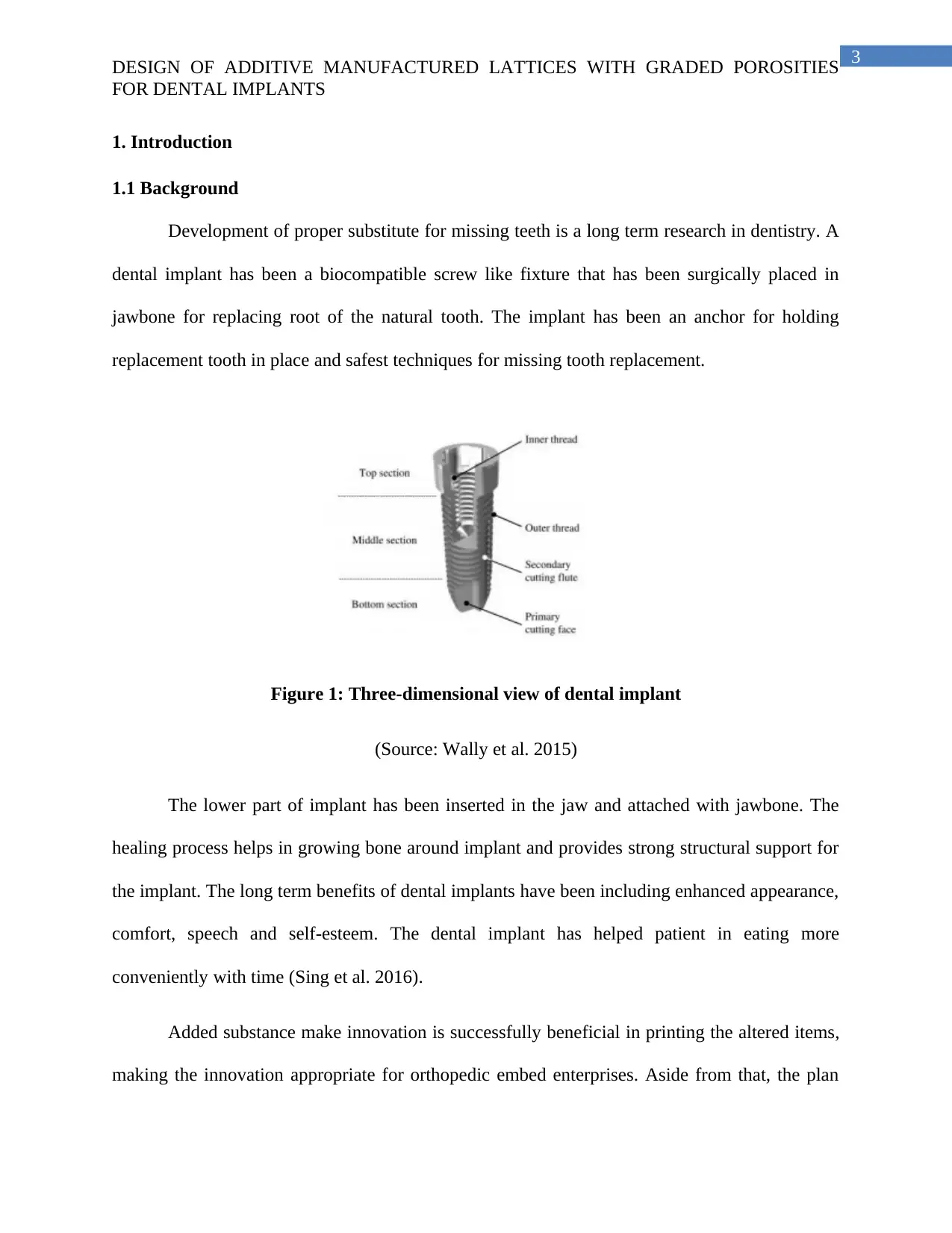
3
DESIGN OF ADDITIVE MANUFACTURED LATTICES WITH GRADED POROSITIES
FOR DENTAL IMPLANTS
1. Introduction
1.1 Background
Development of proper substitute for missing teeth is a long term research in dentistry. A
dental implant has been a biocompatible screw like fixture that has been surgically placed in
jawbone for replacing root of the natural tooth. The implant has been an anchor for holding
replacement tooth in place and safest techniques for missing tooth replacement.
Figure 1: Three-dimensional view of dental implant
(Source: Wally et al. 2015)
The lower part of implant has been inserted in the jaw and attached with jawbone. The
healing process helps in growing bone around implant and provides strong structural support for
the implant. The long term benefits of dental implants have been including enhanced appearance,
comfort, speech and self-esteem. The dental implant has helped patient in eating more
conveniently with time (Sing et al. 2016).
Added substance make innovation is successfully beneficial in printing the altered items,
making the innovation appropriate for orthopedic embed enterprises. Aside from that, the plan
DESIGN OF ADDITIVE MANUFACTURED LATTICES WITH GRADED POROSITIES
FOR DENTAL IMPLANTS
1. Introduction
1.1 Background
Development of proper substitute for missing teeth is a long term research in dentistry. A
dental implant has been a biocompatible screw like fixture that has been surgically placed in
jawbone for replacing root of the natural tooth. The implant has been an anchor for holding
replacement tooth in place and safest techniques for missing tooth replacement.
Figure 1: Three-dimensional view of dental implant
(Source: Wally et al. 2015)
The lower part of implant has been inserted in the jaw and attached with jawbone. The
healing process helps in growing bone around implant and provides strong structural support for
the implant. The long term benefits of dental implants have been including enhanced appearance,
comfort, speech and self-esteem. The dental implant has helped patient in eating more
conveniently with time (Sing et al. 2016).
Added substance make innovation is successfully beneficial in printing the altered items,
making the innovation appropriate for orthopedic embed enterprises. Aside from that, the plan
⊘ This is a preview!⊘
Do you want full access?
Subscribe today to unlock all pages.

Trusted by 1+ million students worldwide
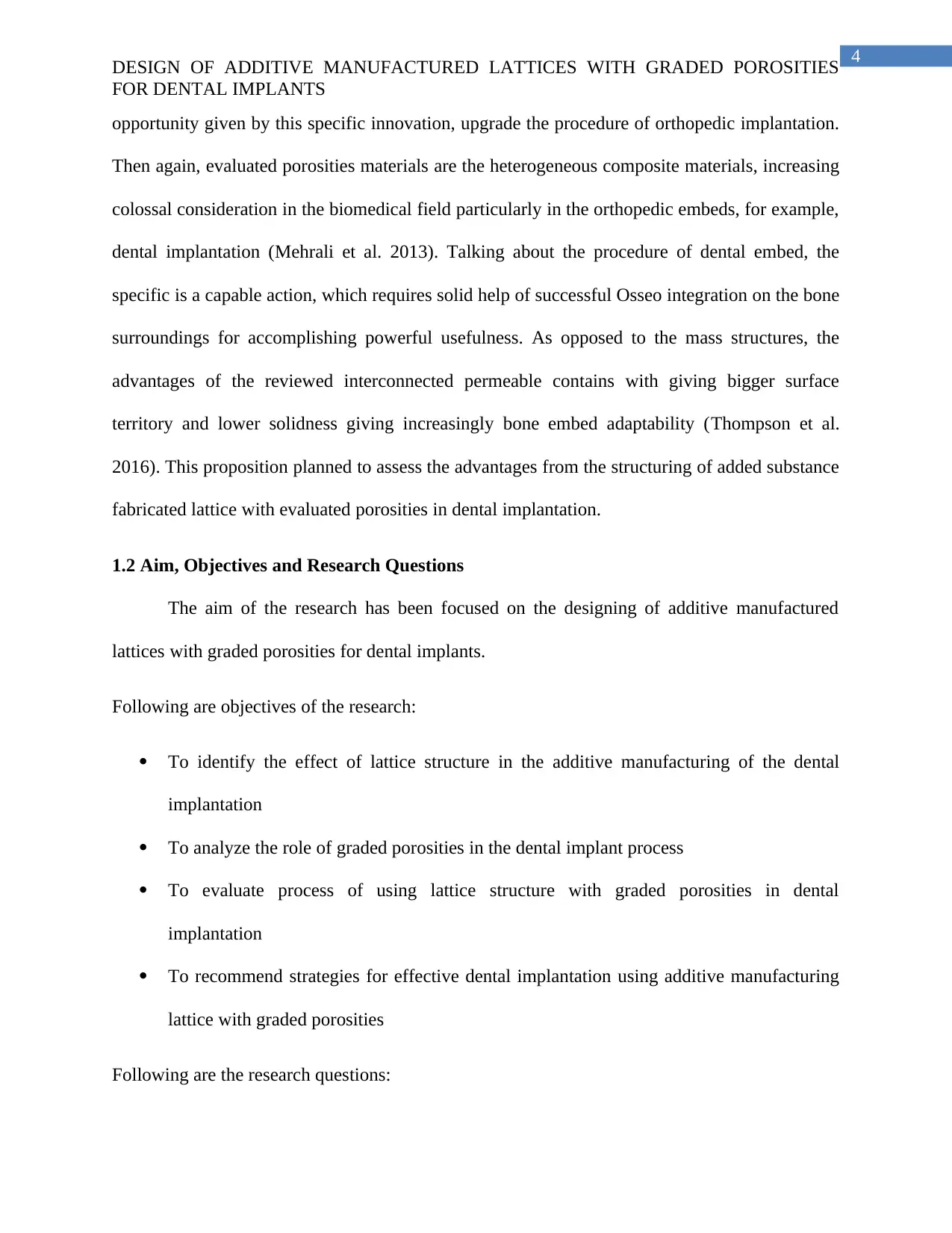
4
DESIGN OF ADDITIVE MANUFACTURED LATTICES WITH GRADED POROSITIES
FOR DENTAL IMPLANTS
opportunity given by this specific innovation, upgrade the procedure of orthopedic implantation.
Then again, evaluated porosities materials are the heterogeneous composite materials, increasing
colossal consideration in the biomedical field particularly in the orthopedic embeds, for example,
dental implantation (Mehrali et al. 2013). Talking about the procedure of dental embed, the
specific is a capable action, which requires solid help of successful Osseo integration on the bone
surroundings for accomplishing powerful usefulness. As opposed to the mass structures, the
advantages of the reviewed interconnected permeable contains with giving bigger surface
territory and lower solidness giving increasingly bone embed adaptability (Thompson et al.
2016). This proposition planned to assess the advantages from the structuring of added substance
fabricated lattice with evaluated porosities in dental implantation.
1.2 Aim, Objectives and Research Questions
The aim of the research has been focused on the designing of additive manufactured
lattices with graded porosities for dental implants.
Following are objectives of the research:
To identify the effect of lattice structure in the additive manufacturing of the dental
implantation
To analyze the role of graded porosities in the dental implant process
To evaluate process of using lattice structure with graded porosities in dental
implantation
To recommend strategies for effective dental implantation using additive manufacturing
lattice with graded porosities
Following are the research questions:
DESIGN OF ADDITIVE MANUFACTURED LATTICES WITH GRADED POROSITIES
FOR DENTAL IMPLANTS
opportunity given by this specific innovation, upgrade the procedure of orthopedic implantation.
Then again, evaluated porosities materials are the heterogeneous composite materials, increasing
colossal consideration in the biomedical field particularly in the orthopedic embeds, for example,
dental implantation (Mehrali et al. 2013). Talking about the procedure of dental embed, the
specific is a capable action, which requires solid help of successful Osseo integration on the bone
surroundings for accomplishing powerful usefulness. As opposed to the mass structures, the
advantages of the reviewed interconnected permeable contains with giving bigger surface
territory and lower solidness giving increasingly bone embed adaptability (Thompson et al.
2016). This proposition planned to assess the advantages from the structuring of added substance
fabricated lattice with evaluated porosities in dental implantation.
1.2 Aim, Objectives and Research Questions
The aim of the research has been focused on the designing of additive manufactured
lattices with graded porosities for dental implants.
Following are objectives of the research:
To identify the effect of lattice structure in the additive manufacturing of the dental
implantation
To analyze the role of graded porosities in the dental implant process
To evaluate process of using lattice structure with graded porosities in dental
implantation
To recommend strategies for effective dental implantation using additive manufacturing
lattice with graded porosities
Following are the research questions:
Paraphrase This Document
Need a fresh take? Get an instant paraphrase of this document with our AI Paraphraser
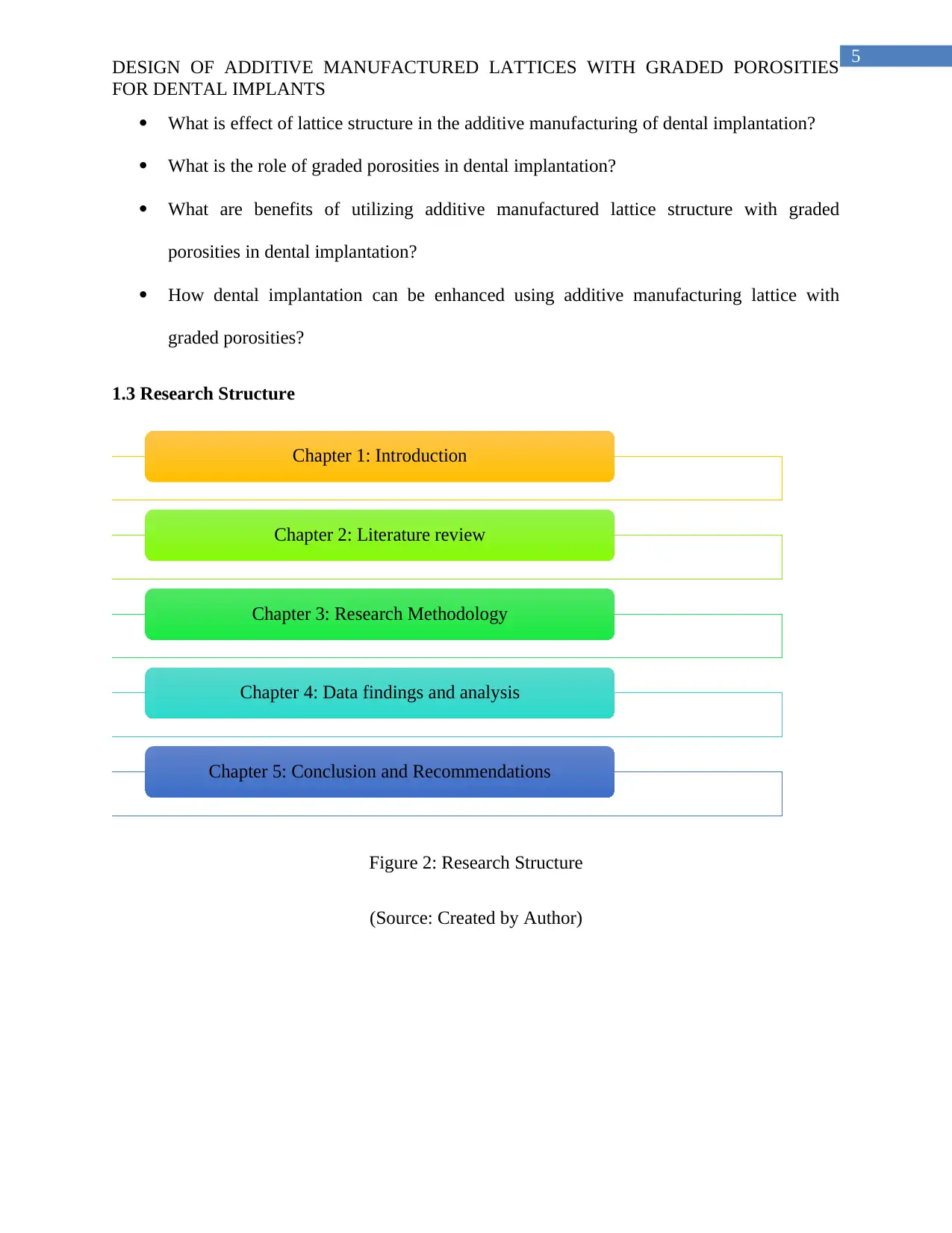
5
DESIGN OF ADDITIVE MANUFACTURED LATTICES WITH GRADED POROSITIES
FOR DENTAL IMPLANTS
What is effect of lattice structure in the additive manufacturing of dental implantation?
What is the role of graded porosities in dental implantation?
What are benefits of utilizing additive manufactured lattice structure with graded
porosities in dental implantation?
How dental implantation can be enhanced using additive manufacturing lattice with
graded porosities?
1.3 Research Structure
Figure 2: Research Structure
(Source: Created by Author)
Chapter 1: Introduction
Chapter 2: Literature review
Chapter 3: Research Methodology
Chapter 4: Data findings and analysis
Chapter 5: Conclusion and Recommendations
DESIGN OF ADDITIVE MANUFACTURED LATTICES WITH GRADED POROSITIES
FOR DENTAL IMPLANTS
What is effect of lattice structure in the additive manufacturing of dental implantation?
What is the role of graded porosities in dental implantation?
What are benefits of utilizing additive manufactured lattice structure with graded
porosities in dental implantation?
How dental implantation can be enhanced using additive manufacturing lattice with
graded porosities?
1.3 Research Structure
Figure 2: Research Structure
(Source: Created by Author)
Chapter 1: Introduction
Chapter 2: Literature review
Chapter 3: Research Methodology
Chapter 4: Data findings and analysis
Chapter 5: Conclusion and Recommendations
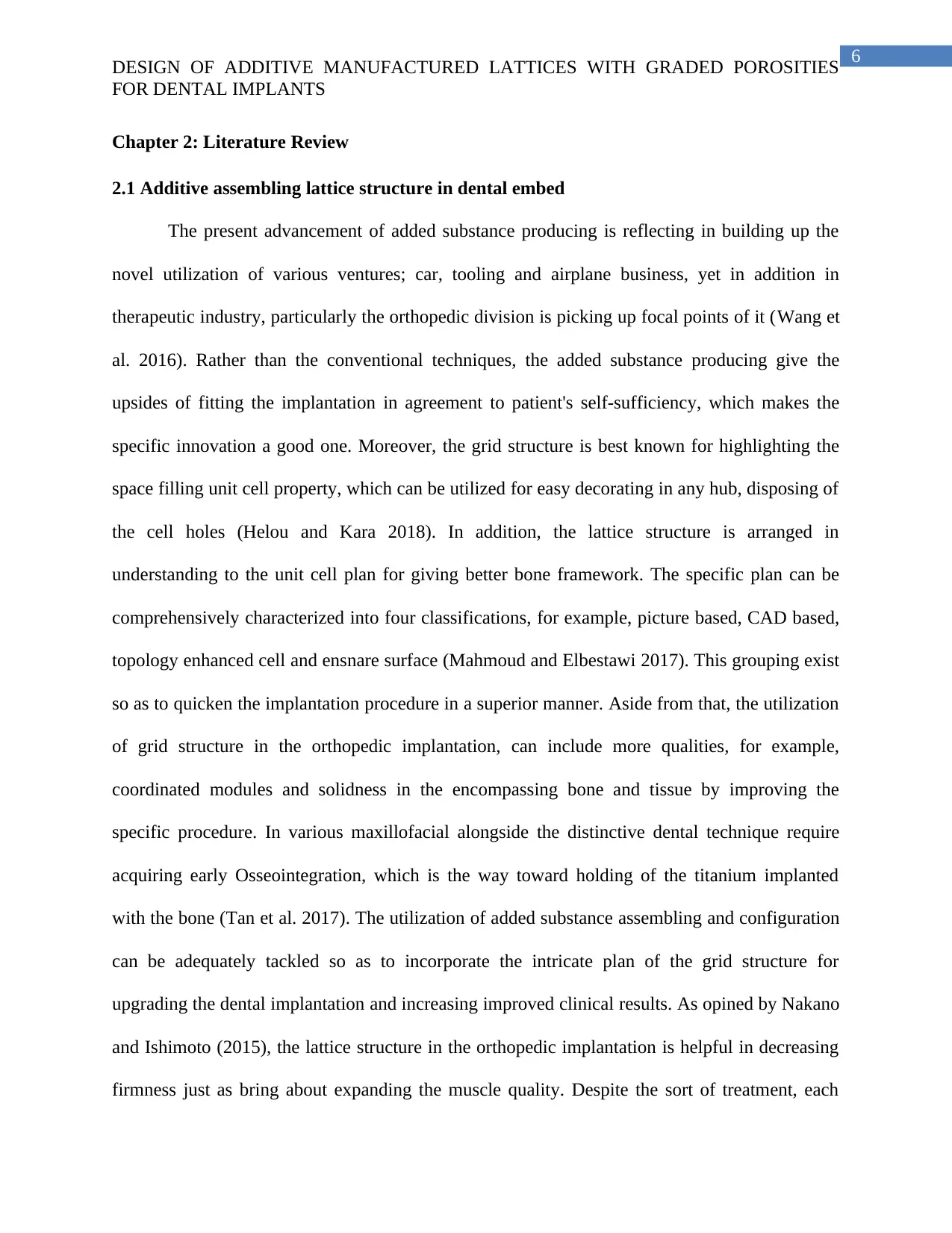
6
DESIGN OF ADDITIVE MANUFACTURED LATTICES WITH GRADED POROSITIES
FOR DENTAL IMPLANTS
Chapter 2: Literature Review
2.1 Additive assembling lattice structure in dental embed
The present advancement of added substance producing is reflecting in building up the
novel utilization of various ventures; car, tooling and airplane business, yet in addition in
therapeutic industry, particularly the orthopedic division is picking up focal points of it (Wang et
al. 2016). Rather than the conventional techniques, the added substance producing give the
upsides of fitting the implantation in agreement to patient's self-sufficiency, which makes the
specific innovation a good one. Moreover, the grid structure is best known for highlighting the
space filling unit cell property, which can be utilized for easy decorating in any hub, disposing of
the cell holes (Helou and Kara 2018). In addition, the lattice structure is arranged in
understanding to the unit cell plan for giving better bone framework. The specific plan can be
comprehensively characterized into four classifications, for example, picture based, CAD based,
topology enhanced cell and ensnare surface (Mahmoud and Elbestawi 2017). This grouping exist
so as to quicken the implantation procedure in a superior manner. Aside from that, the utilization
of grid structure in the orthopedic implantation, can include more qualities, for example,
coordinated modules and solidness in the encompassing bone and tissue by improving the
specific procedure. In various maxillofacial alongside the distinctive dental technique require
acquiring early Osseointegration, which is the way toward holding of the titanium implanted
with the bone (Tan et al. 2017). The utilization of added substance assembling and configuration
can be adequately tackled so as to incorporate the intricate plan of the grid structure for
upgrading the dental implantation and increasing improved clinical results. As opined by Nakano
and Ishimoto (2015), the lattice structure in the orthopedic implantation is helpful in decreasing
firmness just as bring about expanding the muscle quality. Despite the sort of treatment, each
DESIGN OF ADDITIVE MANUFACTURED LATTICES WITH GRADED POROSITIES
FOR DENTAL IMPLANTS
Chapter 2: Literature Review
2.1 Additive assembling lattice structure in dental embed
The present advancement of added substance producing is reflecting in building up the
novel utilization of various ventures; car, tooling and airplane business, yet in addition in
therapeutic industry, particularly the orthopedic division is picking up focal points of it (Wang et
al. 2016). Rather than the conventional techniques, the added substance producing give the
upsides of fitting the implantation in agreement to patient's self-sufficiency, which makes the
specific innovation a good one. Moreover, the grid structure is best known for highlighting the
space filling unit cell property, which can be utilized for easy decorating in any hub, disposing of
the cell holes (Helou and Kara 2018). In addition, the lattice structure is arranged in
understanding to the unit cell plan for giving better bone framework. The specific plan can be
comprehensively characterized into four classifications, for example, picture based, CAD based,
topology enhanced cell and ensnare surface (Mahmoud and Elbestawi 2017). This grouping exist
so as to quicken the implantation procedure in a superior manner. Aside from that, the utilization
of grid structure in the orthopedic implantation, can include more qualities, for example,
coordinated modules and solidness in the encompassing bone and tissue by improving the
specific procedure. In various maxillofacial alongside the distinctive dental technique require
acquiring early Osseointegration, which is the way toward holding of the titanium implanted
with the bone (Tan et al. 2017). The utilization of added substance assembling and configuration
can be adequately tackled so as to incorporate the intricate plan of the grid structure for
upgrading the dental implantation and increasing improved clinical results. As opined by Nakano
and Ishimoto (2015), the lattice structure in the orthopedic implantation is helpful in decreasing
firmness just as bring about expanding the muscle quality. Despite the sort of treatment, each
⊘ This is a preview!⊘
Do you want full access?
Subscribe today to unlock all pages.

Trusted by 1+ million students worldwide
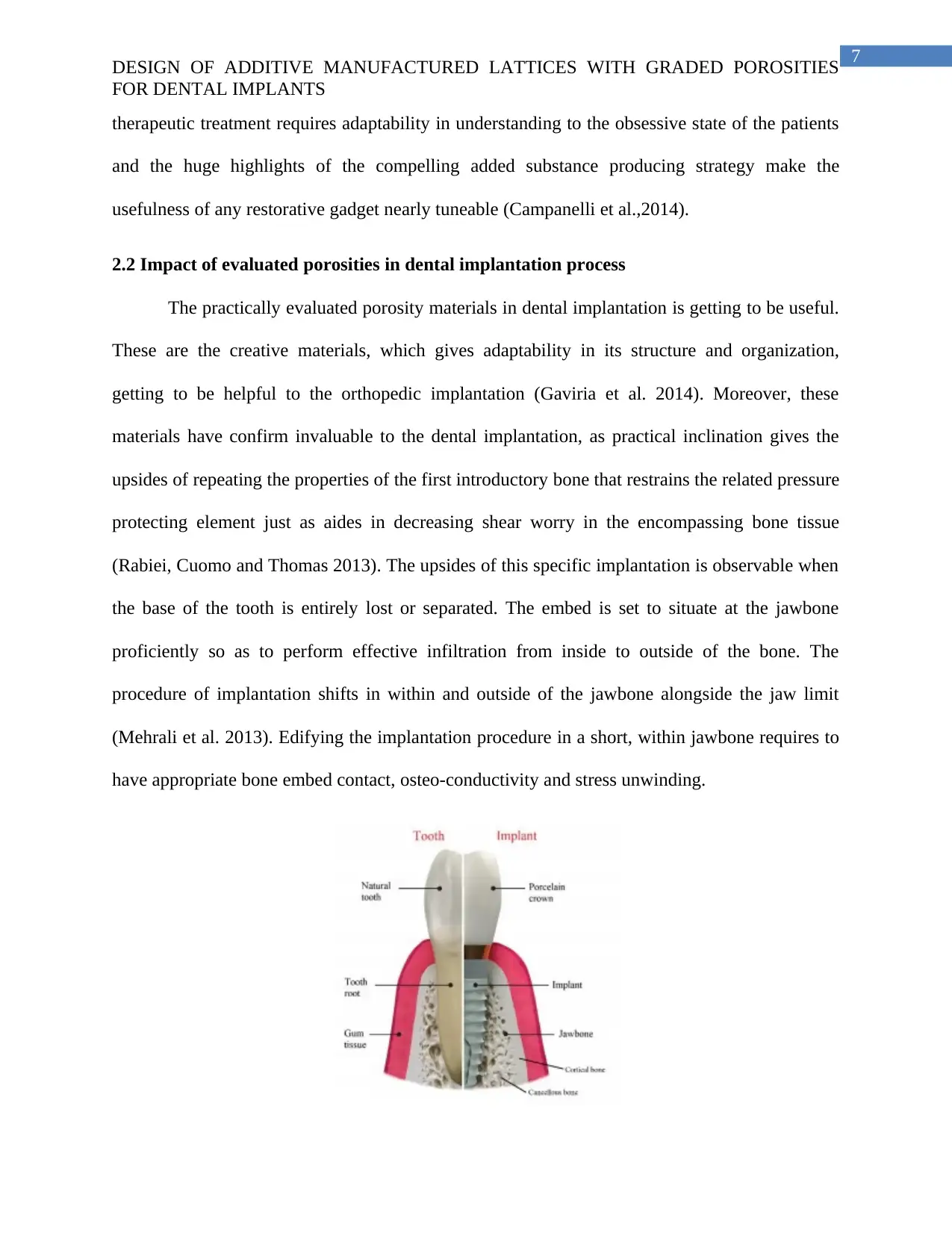
7
DESIGN OF ADDITIVE MANUFACTURED LATTICES WITH GRADED POROSITIES
FOR DENTAL IMPLANTS
therapeutic treatment requires adaptability in understanding to the obsessive state of the patients
and the huge highlights of the compelling added substance producing strategy make the
usefulness of any restorative gadget nearly tuneable (Campanelli et al.,2014).
2.2 Impact of evaluated porosities in dental implantation process
The practically evaluated porosity materials in dental implantation is getting to be useful.
These are the creative materials, which gives adaptability in its structure and organization,
getting to be helpful to the orthopedic implantation (Gaviria et al. 2014). Moreover, these
materials have confirm invaluable to the dental implantation, as practical inclination gives the
upsides of repeating the properties of the first introductory bone that restrains the related pressure
protecting element just as aides in decreasing shear worry in the encompassing bone tissue
(Rabiei, Cuomo and Thomas 2013). The upsides of this specific implantation is observable when
the base of the tooth is entirely lost or separated. The embed is set to situate at the jawbone
proficiently so as to perform effective infiltration from inside to outside of the bone. The
procedure of implantation shifts in within and outside of the jawbone alongside the jaw limit
(Mehrali et al. 2013). Edifying the implantation procedure in a short, within jawbone requires to
have appropriate bone embed contact, osteo-conductivity and stress unwinding.
DESIGN OF ADDITIVE MANUFACTURED LATTICES WITH GRADED POROSITIES
FOR DENTAL IMPLANTS
therapeutic treatment requires adaptability in understanding to the obsessive state of the patients
and the huge highlights of the compelling added substance producing strategy make the
usefulness of any restorative gadget nearly tuneable (Campanelli et al.,2014).
2.2 Impact of evaluated porosities in dental implantation process
The practically evaluated porosity materials in dental implantation is getting to be useful.
These are the creative materials, which gives adaptability in its structure and organization,
getting to be helpful to the orthopedic implantation (Gaviria et al. 2014). Moreover, these
materials have confirm invaluable to the dental implantation, as practical inclination gives the
upsides of repeating the properties of the first introductory bone that restrains the related pressure
protecting element just as aides in decreasing shear worry in the encompassing bone tissue
(Rabiei, Cuomo and Thomas 2013). The upsides of this specific implantation is observable when
the base of the tooth is entirely lost or separated. The embed is set to situate at the jawbone
proficiently so as to perform effective infiltration from inside to outside of the bone. The
procedure of implantation shifts in within and outside of the jawbone alongside the jaw limit
(Mehrali et al. 2013). Edifying the implantation procedure in a short, within jawbone requires to
have appropriate bone embed contact, osteo-conductivity and stress unwinding.
Paraphrase This Document
Need a fresh take? Get an instant paraphrase of this document with our AI Paraphraser
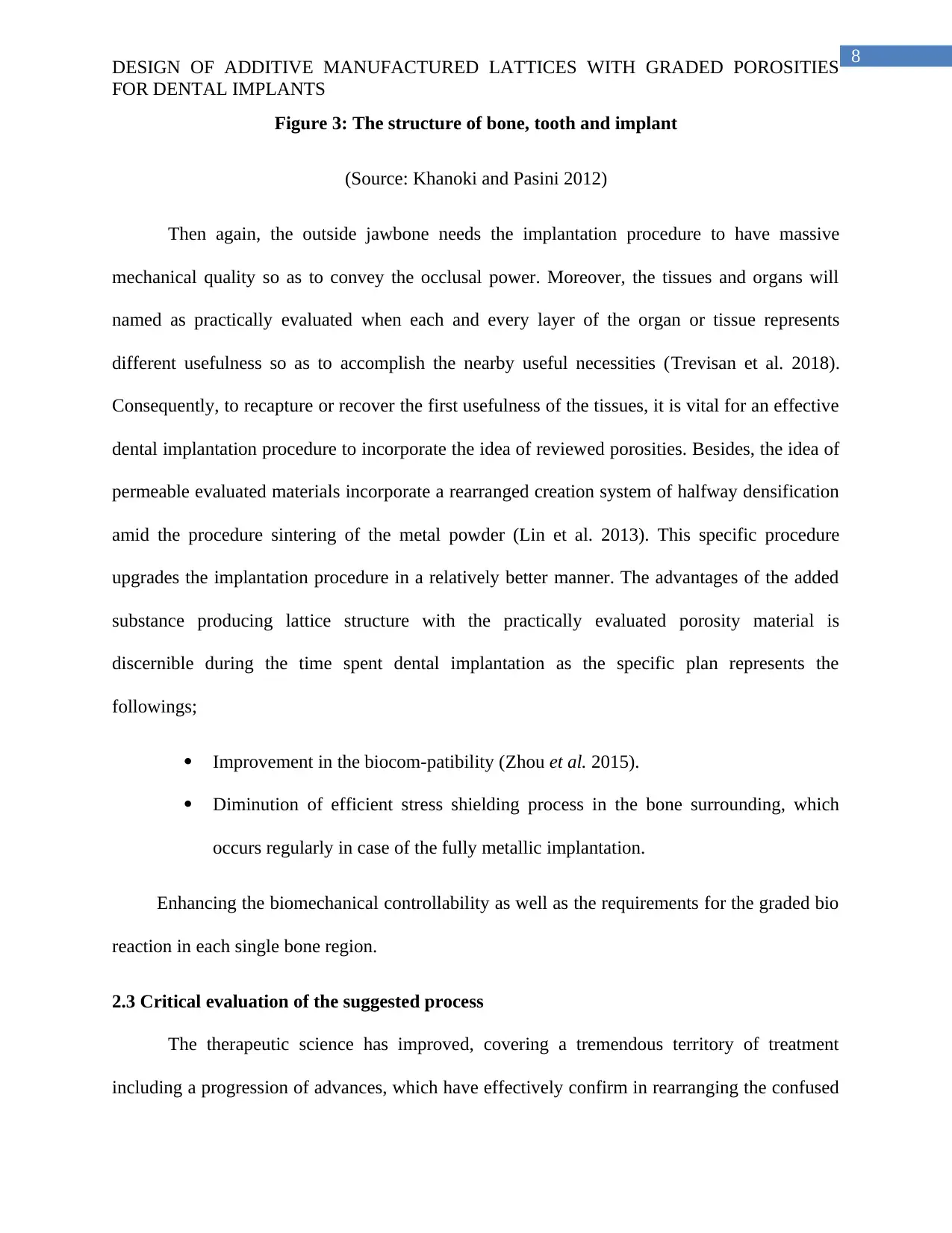
8
DESIGN OF ADDITIVE MANUFACTURED LATTICES WITH GRADED POROSITIES
FOR DENTAL IMPLANTS
Figure 3: The structure of bone, tooth and implant
(Source: Khanoki and Pasini 2012)
Then again, the outside jawbone needs the implantation procedure to have massive
mechanical quality so as to convey the occlusal power. Moreover, the tissues and organs will
named as practically evaluated when each and every layer of the organ or tissue represents
different usefulness so as to accomplish the nearby useful necessities (Trevisan et al. 2018).
Consequently, to recapture or recover the first usefulness of the tissues, it is vital for an effective
dental implantation procedure to incorporate the idea of reviewed porosities. Besides, the idea of
permeable evaluated materials incorporate a rearranged creation system of halfway densification
amid the procedure sintering of the metal powder (Lin et al. 2013). This specific procedure
upgrades the implantation procedure in a relatively better manner. The advantages of the added
substance producing lattice structure with the practically evaluated porosity material is
discernible during the time spent dental implantation as the specific plan represents the
followings;
Improvement in the biocom-patibility (Zhou et al. 2015).
Diminution of efficient stress shielding process in the bone surrounding, which
occurs regularly in case of the fully metallic implantation.
Enhancing the biomechanical controllability as well as the requirements for the graded bio
reaction in each single bone region.
2.3 Critical evaluation of the suggested process
The therapeutic science has improved, covering a tremendous territory of treatment
including a progression of advances, which have effectively confirm in rearranging the confused
DESIGN OF ADDITIVE MANUFACTURED LATTICES WITH GRADED POROSITIES
FOR DENTAL IMPLANTS
Figure 3: The structure of bone, tooth and implant
(Source: Khanoki and Pasini 2012)
Then again, the outside jawbone needs the implantation procedure to have massive
mechanical quality so as to convey the occlusal power. Moreover, the tissues and organs will
named as practically evaluated when each and every layer of the organ or tissue represents
different usefulness so as to accomplish the nearby useful necessities (Trevisan et al. 2018).
Consequently, to recapture or recover the first usefulness of the tissues, it is vital for an effective
dental implantation procedure to incorporate the idea of reviewed porosities. Besides, the idea of
permeable evaluated materials incorporate a rearranged creation system of halfway densification
amid the procedure sintering of the metal powder (Lin et al. 2013). This specific procedure
upgrades the implantation procedure in a relatively better manner. The advantages of the added
substance producing lattice structure with the practically evaluated porosity material is
discernible during the time spent dental implantation as the specific plan represents the
followings;
Improvement in the biocom-patibility (Zhou et al. 2015).
Diminution of efficient stress shielding process in the bone surrounding, which
occurs regularly in case of the fully metallic implantation.
Enhancing the biomechanical controllability as well as the requirements for the graded bio
reaction in each single bone region.
2.3 Critical evaluation of the suggested process
The therapeutic science has improved, covering a tremendous territory of treatment
including a progression of advances, which have effectively confirm in rearranging the confused
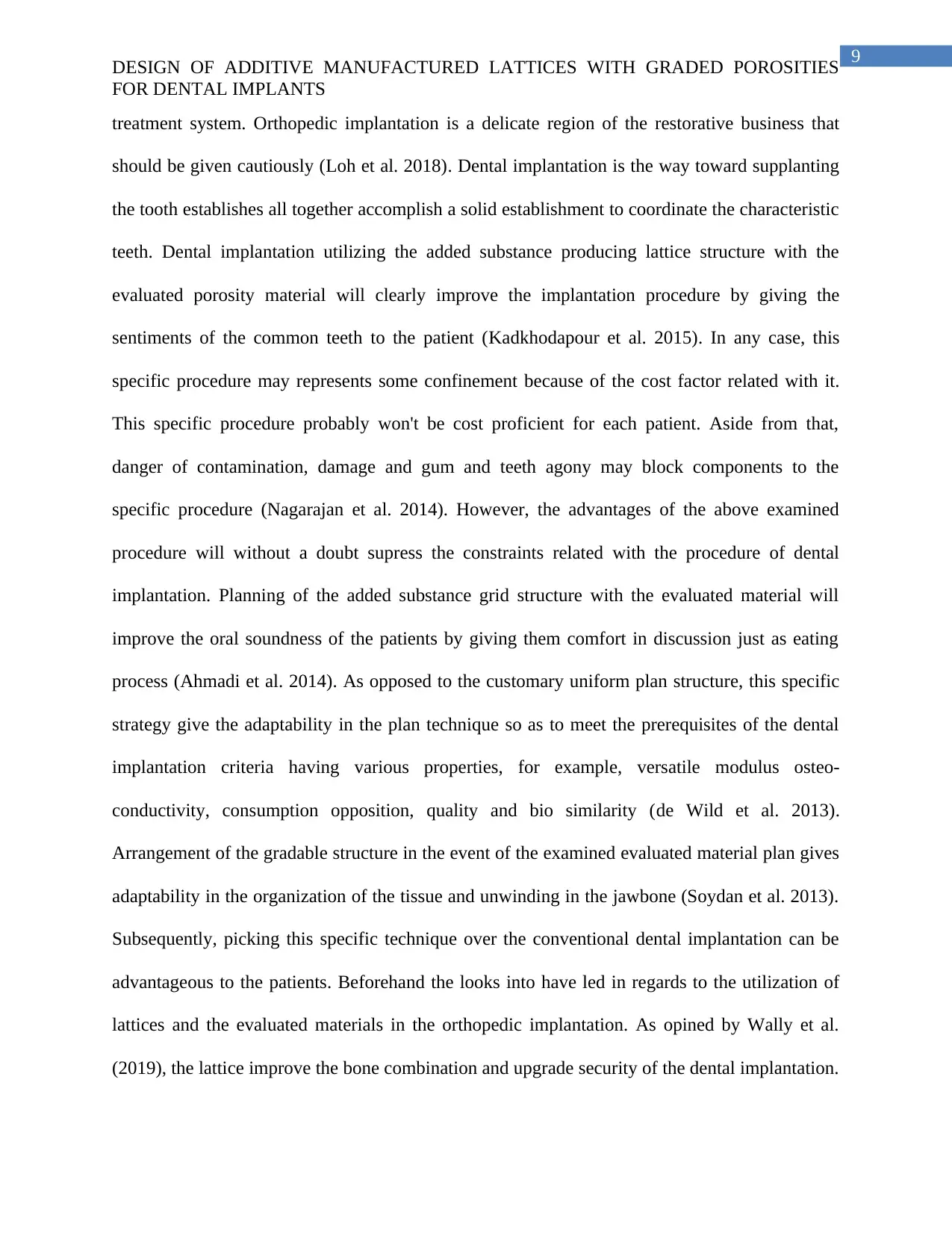
9
DESIGN OF ADDITIVE MANUFACTURED LATTICES WITH GRADED POROSITIES
FOR DENTAL IMPLANTS
treatment system. Orthopedic implantation is a delicate region of the restorative business that
should be given cautiously (Loh et al. 2018). Dental implantation is the way toward supplanting
the tooth establishes all together accomplish a solid establishment to coordinate the characteristic
teeth. Dental implantation utilizing the added substance producing lattice structure with the
evaluated porosity material will clearly improve the implantation procedure by giving the
sentiments of the common teeth to the patient (Kadkhodapour et al. 2015). In any case, this
specific procedure may represents some confinement because of the cost factor related with it.
This specific procedure probably won't be cost proficient for each patient. Aside from that,
danger of contamination, damage and gum and teeth agony may block components to the
specific procedure (Nagarajan et al. 2014). However, the advantages of the above examined
procedure will without a doubt supress the constraints related with the procedure of dental
implantation. Planning of the added substance grid structure with the evaluated material will
improve the oral soundness of the patients by giving them comfort in discussion just as eating
process (Ahmadi et al. 2014). As opposed to the customary uniform plan structure, this specific
strategy give the adaptability in the plan technique so as to meet the prerequisites of the dental
implantation criteria having various properties, for example, versatile modulus osteo-
conductivity, consumption opposition, quality and bio similarity (de Wild et al. 2013).
Arrangement of the gradable structure in the event of the examined evaluated material plan gives
adaptability in the organization of the tissue and unwinding in the jawbone (Soydan et al. 2013).
Subsequently, picking this specific technique over the conventional dental implantation can be
advantageous to the patients. Beforehand the looks into have led in regards to the utilization of
lattices and the evaluated materials in the orthopedic implantation. As opined by Wally et al.
(2019), the lattice improve the bone combination and upgrade security of the dental implantation.
DESIGN OF ADDITIVE MANUFACTURED LATTICES WITH GRADED POROSITIES
FOR DENTAL IMPLANTS
treatment system. Orthopedic implantation is a delicate region of the restorative business that
should be given cautiously (Loh et al. 2018). Dental implantation is the way toward supplanting
the tooth establishes all together accomplish a solid establishment to coordinate the characteristic
teeth. Dental implantation utilizing the added substance producing lattice structure with the
evaluated porosity material will clearly improve the implantation procedure by giving the
sentiments of the common teeth to the patient (Kadkhodapour et al. 2015). In any case, this
specific procedure may represents some confinement because of the cost factor related with it.
This specific procedure probably won't be cost proficient for each patient. Aside from that,
danger of contamination, damage and gum and teeth agony may block components to the
specific procedure (Nagarajan et al. 2014). However, the advantages of the above examined
procedure will without a doubt supress the constraints related with the procedure of dental
implantation. Planning of the added substance grid structure with the evaluated material will
improve the oral soundness of the patients by giving them comfort in discussion just as eating
process (Ahmadi et al. 2014). As opposed to the customary uniform plan structure, this specific
strategy give the adaptability in the plan technique so as to meet the prerequisites of the dental
implantation criteria having various properties, for example, versatile modulus osteo-
conductivity, consumption opposition, quality and bio similarity (de Wild et al. 2013).
Arrangement of the gradable structure in the event of the examined evaluated material plan gives
adaptability in the organization of the tissue and unwinding in the jawbone (Soydan et al. 2013).
Subsequently, picking this specific technique over the conventional dental implantation can be
advantageous to the patients. Beforehand the looks into have led in regards to the utilization of
lattices and the evaluated materials in the orthopedic implantation. As opined by Wally et al.
(2019), the lattice improve the bone combination and upgrade security of the dental implantation.
⊘ This is a preview!⊘
Do you want full access?
Subscribe today to unlock all pages.

Trusted by 1+ million students worldwide
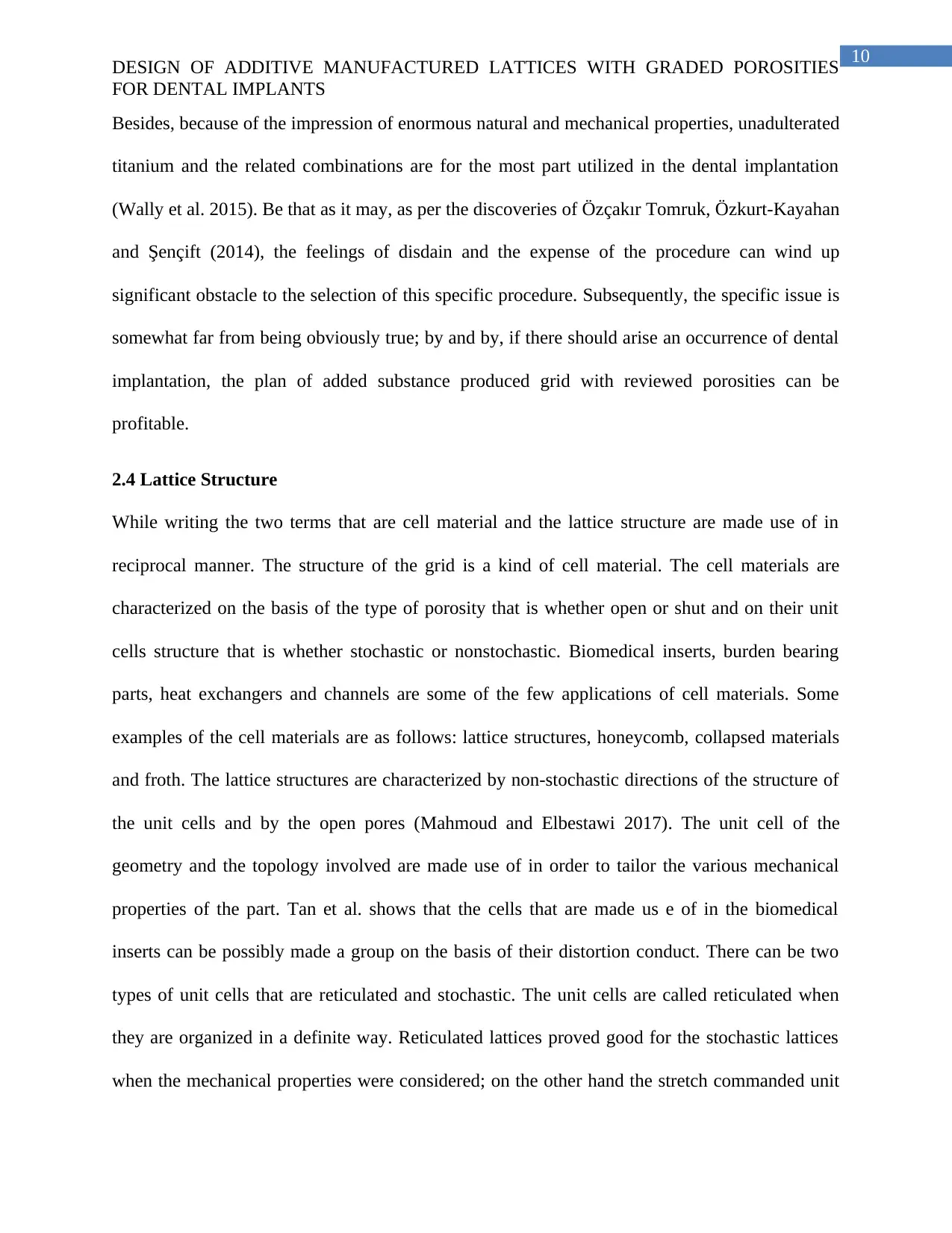
10
DESIGN OF ADDITIVE MANUFACTURED LATTICES WITH GRADED POROSITIES
FOR DENTAL IMPLANTS
Besides, because of the impression of enormous natural and mechanical properties, unadulterated
titanium and the related combinations are for the most part utilized in the dental implantation
(Wally et al. 2015). Be that as it may, as per the discoveries of Özçakır Tomruk, Özkurt-Kayahan
and Şençift (2014), the feelings of disdain and the expense of the procedure can wind up
significant obstacle to the selection of this specific procedure. Subsequently, the specific issue is
somewhat far from being obviously true; by and by, if there should arise an occurrence of dental
implantation, the plan of added substance produced grid with reviewed porosities can be
profitable.
2.4 Lattice Structure
While writing the two terms that are cell material and the lattice structure are made use of in
reciprocal manner. The structure of the grid is a kind of cell material. The cell materials are
characterized on the basis of the type of porosity that is whether open or shut and on their unit
cells structure that is whether stochastic or nonstochastic. Biomedical inserts, burden bearing
parts, heat exchangers and channels are some of the few applications of cell materials. Some
examples of the cell materials are as follows: lattice structures, honeycomb, collapsed materials
and froth. The lattice structures are characterized by non-stochastic directions of the structure of
the unit cells and by the open pores (Mahmoud and Elbestawi 2017). The unit cell of the
geometry and the topology involved are made use of in order to tailor the various mechanical
properties of the part. Tan et al. shows that the cells that are made us e of in the biomedical
inserts can be possibly made a group on the basis of their distortion conduct. There can be two
types of unit cells that are reticulated and stochastic. The unit cells are called reticulated when
they are organized in a definite way. Reticulated lattices proved good for the stochastic lattices
when the mechanical properties were considered; on the other hand the stretch commanded unit
DESIGN OF ADDITIVE MANUFACTURED LATTICES WITH GRADED POROSITIES
FOR DENTAL IMPLANTS
Besides, because of the impression of enormous natural and mechanical properties, unadulterated
titanium and the related combinations are for the most part utilized in the dental implantation
(Wally et al. 2015). Be that as it may, as per the discoveries of Özçakır Tomruk, Özkurt-Kayahan
and Şençift (2014), the feelings of disdain and the expense of the procedure can wind up
significant obstacle to the selection of this specific procedure. Subsequently, the specific issue is
somewhat far from being obviously true; by and by, if there should arise an occurrence of dental
implantation, the plan of added substance produced grid with reviewed porosities can be
profitable.
2.4 Lattice Structure
While writing the two terms that are cell material and the lattice structure are made use of in
reciprocal manner. The structure of the grid is a kind of cell material. The cell materials are
characterized on the basis of the type of porosity that is whether open or shut and on their unit
cells structure that is whether stochastic or nonstochastic. Biomedical inserts, burden bearing
parts, heat exchangers and channels are some of the few applications of cell materials. Some
examples of the cell materials are as follows: lattice structures, honeycomb, collapsed materials
and froth. The lattice structures are characterized by non-stochastic directions of the structure of
the unit cells and by the open pores (Mahmoud and Elbestawi 2017). The unit cell of the
geometry and the topology involved are made use of in order to tailor the various mechanical
properties of the part. Tan et al. shows that the cells that are made us e of in the biomedical
inserts can be possibly made a group on the basis of their distortion conduct. There can be two
types of unit cells that are reticulated and stochastic. The unit cells are called reticulated when
they are organized in a definite way. Reticulated lattices proved good for the stochastic lattices
when the mechanical properties were considered; on the other hand the stretch commanded unit
Paraphrase This Document
Need a fresh take? Get an instant paraphrase of this document with our AI Paraphraser
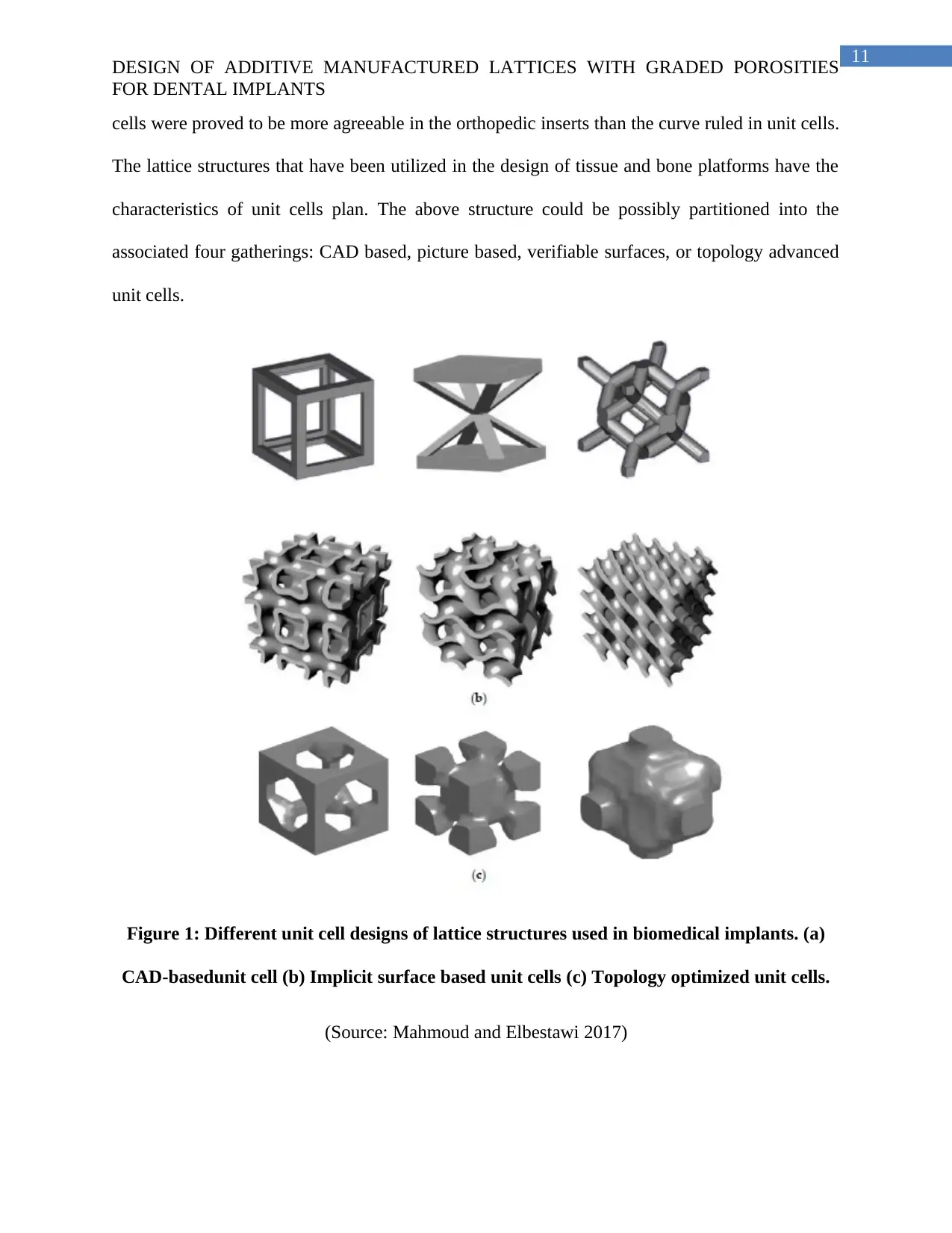
11
DESIGN OF ADDITIVE MANUFACTURED LATTICES WITH GRADED POROSITIES
FOR DENTAL IMPLANTS
cells were proved to be more agreeable in the orthopedic inserts than the curve ruled in unit cells.
The lattice structures that have been utilized in the design of tissue and bone platforms have the
characteristics of unit cells plan. The above structure could be possibly partitioned into the
associated four gatherings: CAD based, picture based, verifiable surfaces, or topology advanced
unit cells.
Figure 1: Different unit cell designs of lattice structures used in biomedical implants. (a)
CAD-basedunit cell (b) Implicit surface based unit cells (c) Topology optimized unit cells.
(Source: Mahmoud and Elbestawi 2017)
DESIGN OF ADDITIVE MANUFACTURED LATTICES WITH GRADED POROSITIES
FOR DENTAL IMPLANTS
cells were proved to be more agreeable in the orthopedic inserts than the curve ruled in unit cells.
The lattice structures that have been utilized in the design of tissue and bone platforms have the
characteristics of unit cells plan. The above structure could be possibly partitioned into the
associated four gatherings: CAD based, picture based, verifiable surfaces, or topology advanced
unit cells.
Figure 1: Different unit cell designs of lattice structures used in biomedical implants. (a)
CAD-basedunit cell (b) Implicit surface based unit cells (c) Topology optimized unit cells.
(Source: Mahmoud and Elbestawi 2017)
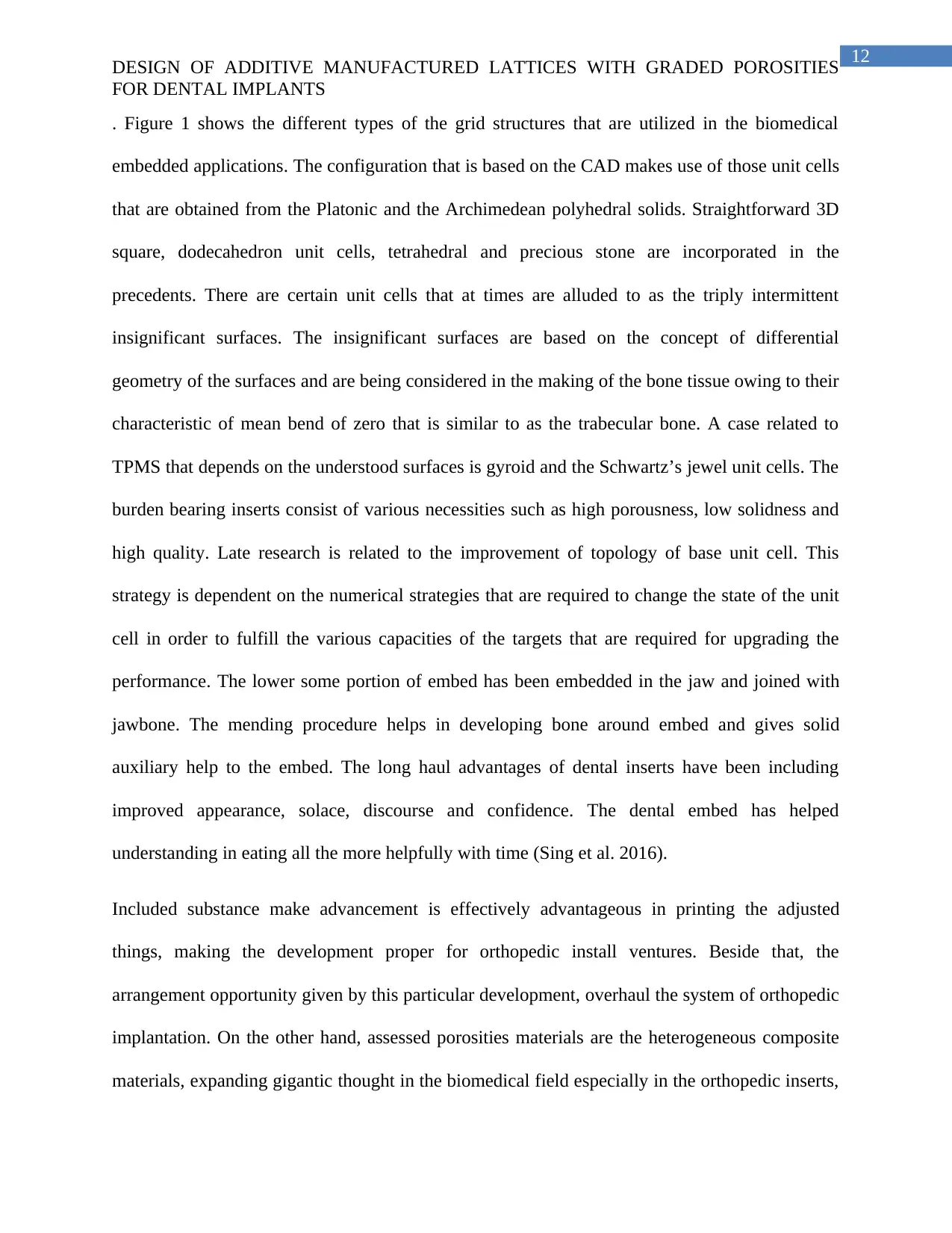
12
DESIGN OF ADDITIVE MANUFACTURED LATTICES WITH GRADED POROSITIES
FOR DENTAL IMPLANTS
. Figure 1 shows the different types of the grid structures that are utilized in the biomedical
embedded applications. The configuration that is based on the CAD makes use of those unit cells
that are obtained from the Platonic and the Archimedean polyhedral solids. Straightforward 3D
square, dodecahedron unit cells, tetrahedral and precious stone are incorporated in the
precedents. There are certain unit cells that at times are alluded to as the triply intermittent
insignificant surfaces. The insignificant surfaces are based on the concept of differential
geometry of the surfaces and are being considered in the making of the bone tissue owing to their
characteristic of mean bend of zero that is similar to as the trabecular bone. A case related to
TPMS that depends on the understood surfaces is gyroid and the Schwartz’s jewel unit cells. The
burden bearing inserts consist of various necessities such as high porousness, low solidness and
high quality. Late research is related to the improvement of topology of base unit cell. This
strategy is dependent on the numerical strategies that are required to change the state of the unit
cell in order to fulfill the various capacities of the targets that are required for upgrading the
performance. The lower some portion of embed has been embedded in the jaw and joined with
jawbone. The mending procedure helps in developing bone around embed and gives solid
auxiliary help to the embed. The long haul advantages of dental inserts have been including
improved appearance, solace, discourse and confidence. The dental embed has helped
understanding in eating all the more helpfully with time (Sing et al. 2016).
Included substance make advancement is effectively advantageous in printing the adjusted
things, making the development proper for orthopedic install ventures. Beside that, the
arrangement opportunity given by this particular development, overhaul the system of orthopedic
implantation. On the other hand, assessed porosities materials are the heterogeneous composite
materials, expanding gigantic thought in the biomedical field especially in the orthopedic inserts,
DESIGN OF ADDITIVE MANUFACTURED LATTICES WITH GRADED POROSITIES
FOR DENTAL IMPLANTS
. Figure 1 shows the different types of the grid structures that are utilized in the biomedical
embedded applications. The configuration that is based on the CAD makes use of those unit cells
that are obtained from the Platonic and the Archimedean polyhedral solids. Straightforward 3D
square, dodecahedron unit cells, tetrahedral and precious stone are incorporated in the
precedents. There are certain unit cells that at times are alluded to as the triply intermittent
insignificant surfaces. The insignificant surfaces are based on the concept of differential
geometry of the surfaces and are being considered in the making of the bone tissue owing to their
characteristic of mean bend of zero that is similar to as the trabecular bone. A case related to
TPMS that depends on the understood surfaces is gyroid and the Schwartz’s jewel unit cells. The
burden bearing inserts consist of various necessities such as high porousness, low solidness and
high quality. Late research is related to the improvement of topology of base unit cell. This
strategy is dependent on the numerical strategies that are required to change the state of the unit
cell in order to fulfill the various capacities of the targets that are required for upgrading the
performance. The lower some portion of embed has been embedded in the jaw and joined with
jawbone. The mending procedure helps in developing bone around embed and gives solid
auxiliary help to the embed. The long haul advantages of dental inserts have been including
improved appearance, solace, discourse and confidence. The dental embed has helped
understanding in eating all the more helpfully with time (Sing et al. 2016).
Included substance make advancement is effectively advantageous in printing the adjusted
things, making the development proper for orthopedic install ventures. Beside that, the
arrangement opportunity given by this particular development, overhaul the system of orthopedic
implantation. On the other hand, assessed porosities materials are the heterogeneous composite
materials, expanding gigantic thought in the biomedical field especially in the orthopedic inserts,
⊘ This is a preview!⊘
Do you want full access?
Subscribe today to unlock all pages.

Trusted by 1+ million students worldwide
1 out of 28
Your All-in-One AI-Powered Toolkit for Academic Success.
+13062052269
info@desklib.com
Available 24*7 on WhatsApp / Email
![[object Object]](/_next/static/media/star-bottom.7253800d.svg)
Unlock your academic potential
Copyright © 2020–2025 A2Z Services. All Rights Reserved. Developed and managed by ZUCOL.


